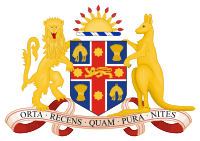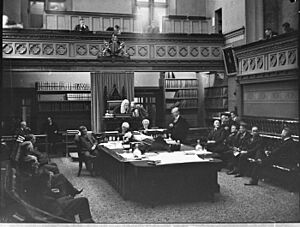New South Wales Legislative Assembly facts for kids
Quick facts for kids Legislative Assembly |
|
|---|---|
| 58th Parliament | |
 |
|
| Type | |
| Type | |
| History | |
| Founded | 22 May 1856 |
| Leadership | |
|
Speaker
|
Greg Piper, Independent
Since 9 May 2023 |
|
Deputy Speaker
|
Sonia Hornery, Labor
Since 9 May 2023 |
|
Leader of the House
|
Ron Hoenig, Labor
Since 5 April 2023 |
|
Government Whip
|
Nathan Hagarty, Labor
Since 17 October 2023 |
|
Deputy Government Whip
|
Janelle Saffin, Labor
Since 3 May 2023 |
|
Manager of Opposition Business
|
Alister Henskens, Liberal
Since 3 May 2023 |
| Structure | |
| Seats | 93 |
 |
|
|
Political groups
|
Government (45)
Opposition (35)
Crossbench (12)
|
|
Length of term
|
4 years |
| Elections | |
| Optional preferential voting | |
|
Last election
|
25 March 2023 |
|
Next election
|
2027 |
| Meeting place | |
| Legislative Assembly Chamber Parliament House, Sydney, New South Wales, Australia |
|
| Website | |
| NSW Legislative Assembly | |
The New South Wales Legislative Assembly is an important part of the government in the Australian state of New South Wales. It is one of two main groups, or "houses," that make up the Parliament of New South Wales. The other group is called the New South Wales Legislative Council. Both of these groups meet at Parliament House in Sydney, the state capital.
The Legislative Assembly has 93 members. These members are chosen by people voting in different areas, called "seats" or "constituencies." The voting system used is called optional preferential voting. This means voters can choose their favorite candidate and also rank other candidates in order of preference.
The person in charge of the Legislative Assembly is called the Speaker. Members of the Legislative Assembly are often called "MPs," which stands for "Members of Parliament." For a long time, they were called "MLAs."
Sometimes, the Assembly is nicknamed the bearpit. This is because debates can get very lively and intense. People say it's like a dramatic show where politicians strongly argue their points.
Contents
History of the Assembly
The Legislative Assembly started in 1856. This was when New South Wales, which was then a Crown Colony, set up a two-house parliament. At first, only men could be members of the Assembly. Also, only about half of the men could vote. They had to own a certain amount of property or earn a certain income.
But things changed quickly! Two years later, a new law called the Electoral Reform Act was passed. This law made the system much fairer. Any man who had lived in the colony for six months could now vote. Also, men no longer needed to own property to become a candidate.
After Australia became a federation in 1901, the New South Wales parliament became a state parliament. Women in New South Wales got the right to vote in 1902. Later, in 1918, they also gained the right to become members of the Assembly. The first woman was successfully elected in 1925.
The Assembly Chamber
The Legislative Assembly meets in the oldest parliament room in Australia. It was first built in 1843 for the Legislative Council. It has been used continuously by the Legislative Assembly since 1856. The room is green, which is a tradition from the British Parliament for their lower houses.
How the Assembly Works
Most new laws start in the Legislative Assembly. The political party or group of parties that wins the most seats in the Assembly gets to form the government. The Governor officially invites them to do this.
The leader of that winning party then becomes the Premier of New South Wales. Other important members of the party become "ministers." They are in charge of different areas, like education or health. Since political parties usually vote together, most laws suggested by the government usually pass in the Assembly.
Just like in the national parliament and other Australian states, voting in elections for the Assembly is compulsory for everyone over 18. Elections happen every four years. They are held on the fourth Saturday in March. This rule was set after a public vote in 1995. An early election can only happen if the government loses a "vote of no confidence." This means they no longer have enough support from the members.
Who is in the Assembly Now?
The Legislative Assembly has 93 members. Here's a simple look at how the seats are currently divided among the main political groups:
- The Labor Party holds 45 seats.
- The Liberal Party holds 25 seats.
- The Nationals hold 11 seats.
- The Greens hold 3 seats.
- There are 9 Independent members. These members do not belong to a major political party.
- Currently, 1 seat is vacant.
To pass a new law, a majority of votes is needed. This means at least 47 votes are required for a law to pass in the Assembly.
People Who Help the Assembly Run
The Legislative Assembly has important administrative officers who help it work smoothly.
The Clerk
The Clerk of the House is the most senior administrative officer. This person gives advice to the Speaker and other members of parliament. They help with rules about how parliament works and how it is managed. This role is similar to the Clerk in the British House of Commons.
The Serjeant-at-Arms
The Serjeant-at-Arms has special duties. They are the keeper of the "mace." The mace is a special stick that shows the authority of the House and the Speaker. The Serjeant also carries formal messages between the Legislative Assembly and the Legislative Council.
This person can remove people who are being disorderly from the Assembly room or from the public viewing areas. They do this if the Speaker tells them to. The Serjeant also helps with things like office space for members, transport, mail, and security for the House. They also help arrange school visits. When a meeting starts, the Serjeant often stands at the door to keep order.
See also
 In Spanish: Asamblea Legislativa de Nueva Gales del Sur para niños
In Spanish: Asamblea Legislativa de Nueva Gales del Sur para niños


